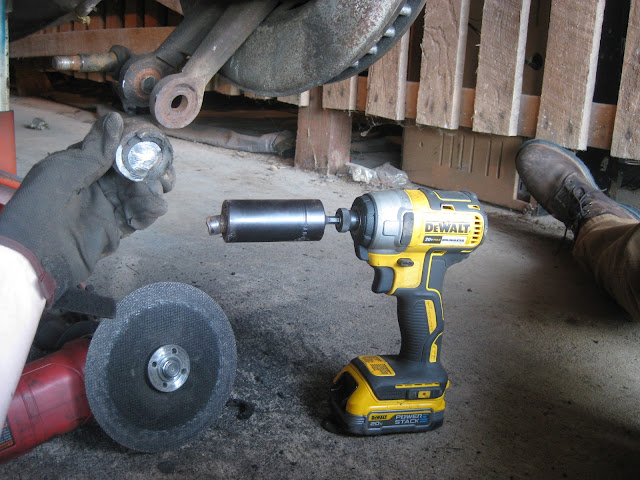Once again, the pictures belie the amount of time and work that went into the following steps. This took place over the course of 2 and 1/2 weeks. Among other things I've also been building sliding barn doors for the carports. It has been hazardously hot and humid and the limited airflow in the barn has not been pleasant, but not as bad as working on the doors in the direct sunlight. My friend Nick came over and helped me move the engine stand from one small barn room and into the tack room and install the differential on the engine stand. It involved some careful maneuvering to make sure nothing was damaged during the move.
The scope of this entire project has seemed impossible, however with the help of the forums I just focus on how to make incremental progress and solve each new problem one step at a time, as it arises. Despite having ridden and driven C3 Corvettes my entire life, I had no knowledge of their suspension until I began this project, so there has been a lot of learning in a short amount of time.
I needed to figure out the condition of the side yokes, so I finally ordered a dial indicator and stand. I've wanted one for quite a while and now was finally the time.
After draining the oil overnight, the first thing to do was to measure the end play on the side yokes. I found the driver side had .037" and the passenger side had .043".
After opening up the differential I was very glad to see that the ends of the splines appeared to be in good shape at first glance. When my mower broke the keyway on the wheel spindle I had to borrow a set of strong ring pliers. When our friends that owned Branham's Trucking Co. sold out and closed their doors, Dad and I had gone to their auction at the end of 2021 and I picked up their shops C-ring pliers and this was the first chance I'd had to use them.
The yokes slid right out with no problem. They had the slightest of resistance which gave way with a gentle tug. The bearing surfaces appeared to be in good shape.
The tips of the splines also appeared to be in good order as well. The measurement from the inside edge of the c-clip groove to the end of the spline was .186" on the driver side and .180" on the passenger side, which is within specs. It was a big relief to find them in such good condition because remanufactured side yokes have become very difficult to source.
Before taking everything apart I spun the rear end and it all moved freely and there was no feeling of bad bearings. Visual inspection of the bearings didn't show any problems either.
The center pin did show some signs of wear, but nothing that was concerning.
Then I moved on to checking the backlash on the ring gear. It measured .011", which thankfully was good. I also tested the backlash on the pinion yoke and it has 0 endplay.
Even though the side yokes were in good condition, I still had a problem. The u-bolt straps were all seized inside the holes and my drill press kicked the bucket a while back. These straps were the original cause for this quick u-joint replacement turning into a nightmare. One of the nuts had also rounded off back when I was trying to remove it while on the car. This step was extremely frustrating because no matter how I mounted the yoke in the vise it would not hold itself square. I also did not want to clamp down too hard and risk breaking it. First, I had to try to get the rounded nut off. I finally got a socket to bite it, but then the bolt began to turn. I eventually had to grind down the backside and hammer it out with the nut still seized.
The process for the rest of them was similar. I had to heat the yoke, then grab the stud with vice grips and try to work it back and forth. I had been periodically soaking the studs with penetrating oil for several days. Eventually after heating and working it back and forth I would be able to get the stud to twist back and forth just a little.
After it began to twist just a little bit I knew it had broken the rust bond, so I would use a punch and drive it out, which did not work well even when I supported the bottom of the yoke. It was definitely an exercise in patience.
After a whole lot of heating, and vice-gripping, and hammering, readjusting the vice and going to the house to get a flyswatter to kill the legion of hornets which were trying to build a nest next to the light bulb over my head, all 8 studs finally left home for the first time since 1975.






















